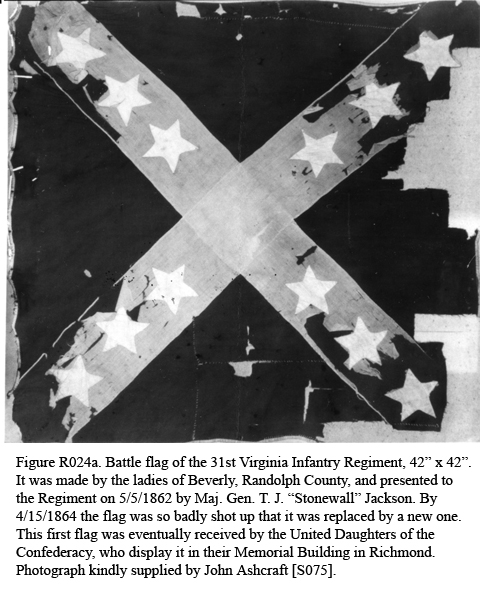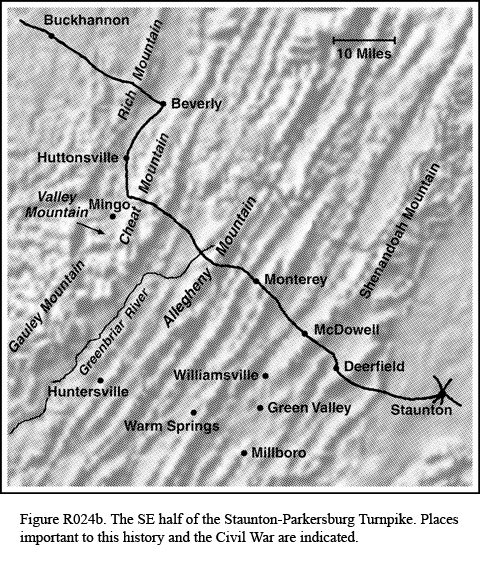R024
The 31st Virginia Infantry Regiment (Fig. R024a) and the Staunton-Parkersburg Turnpike
(1996) In the Civil War nine of Edward Wood’s [R003] Randolph County grandsons enlisted in the same Virginia Infantry Regiment, the 31st. In fact they were all in the same Company (F). They would have made up about 10% of the strength of the company. These were John M. and Joseph A. Wood; Jacob, James W., and William E. Lemon; Henson H. Douglas; John D. Moore; and James and William H. Wilson. Only three of the nine survived the war. Two other grandsons, Samuel A. and Thomas J. Moore, served in the 19th Virginia Cavalry.
Randolph County was divided in its loyalties during the war, but secession sentiment was prevalent. The number of Confederate soldiers from the County was about twice the number that fought for the Union [S087]. Certainly Joseph Wood’s descendants in Randolph County presented a solid front. I don’t know whether they owned slaves, or how much of an issue this was for them. There were few slaves in the counties that now constitute West Virginia. They made up only 5% of the population in West Virginia (overall), vs. ~33% in the Virginia counties to the east of them. (The Bath County population was 25% slave in 1860. [S095] attributes this high number, for a mountain county, to “its summer resorts and fertile river bottoms.”)
The 31st Virginia Infantry Regiment was raised in the mountain counties of Virginia. Each of its ten companies was recruited in a particular county, which is why our Randolph County cousins were in the same company. Members of Company A were from Marion County in what is now W.V.; Company B, Pendleton County W.Va.; Company C, Harrison County W.V.; Company D, Gilmer County W.V.; Company E, Highland County Va.; Company F, Randolph County W.V.; Company G, Pocahontas County W.V.; Company H, Barbour County W.V.; Company I, Lewis County W.V.; Company K, eastern Barbour County W.V. These companies were organized separately in the first chaotic days of the war and fought in the earliest important Civil War battles, which were in West Virginia (especially the battles of Philippi, 6/3/1861, and Rich Mountain, 7/11/1861). They were combined into the 31st Infantry Regiment about June 8, 1861.
Roads are crucial to military strategy. Wagons, artillery, and columns of men have to be moved over roads; they cannot strike across country or scale mountains. In the Civil War an important potential invasion route was the road from Parkersburg W.V. (in Union territory, on the Ohio River) across the mountains to Staunton Va. (Fig. R024b). It lead through Weston, in Lewis County W.V. and Buckhannon, in Upshur County, then through a pass in Rich Mountain into Beverly, in Randolph County; up the Tygart Valley River through Huttonsville; across Cheat Mountain into Pocahontas County; then into Highland County Va. and through Monterey and McDowell; across the Bullpasture and Cowpasture Rivers and through a pass in Shenandoah Mountain into Augusta County; across the Calfpasture River and thence to Staunton.
The earliest battles of the war focussed on this old Staunton-Parkersburg Turnpike, and our ancestors helped defend it. Virginia seceded from the Union 4/17/1861, and in June a Union force of Ohio and Indiana Regiments under Gen. George B. McClellan was sent down the Turnpike. Gen. Robert E. Lee, then commanding the military forces of the Commonwealth of Virginia, was assigned to organize the companies forming in the mountain counties and stop McClellan. McClellan decisively defeated the poorly-trained, poorly-armed Confederates at the battles of Philippi and Rich Mountain. Frank Wood [R004], along with the rest of the Bath Greys of the 25th Virginia Infantry Regiment, was captured at Rich Mountain (a battle at the point where the Turnpike crosses the mountain). By July 14 the 31st Virginia Infantry had been driven ignominiously from what is now West Virginia. It fell back on Monterey, in Highland County. There it reequipped and regrouped, joining a Confederate Brigade that included other Regiments from Virginia, Georgia, and Arkansas. The 31st Virginia was sent back up the Turnpike and by July 24 it occupied the crest of Allegheny Mountain. Across the Greenbrier River it faced a heavily fortified Union encampment where the Turnpike crosses the crest of Cheat Mountain. Most of the rest of the Brigade took up a position near Huntersville, in Pocahontas County.
In August the Brigade moved N to the vicinity of Valley Mountain; the 31st Virginia advanced a few miles NW to the Greenbriar River. In September Lee planned a pincers attack on the Union Cheat Mountain stronghold. The 31st Virginia would strike from the SE, and three other regiments from the Valley Mountain/Huntersville force would attack from other directions. This operation, under the command of Col. Albert Rust of Arkansas, was the occasion on which the scouting talents of Tommie E. Wood [R261] were enlisted. Due to a lack of coordination between the Regiments, the attack never came off.
In September William A. Reynolds [see R265] and Jimmy Circle from the Woodtown area of Botetourt County, who drove wagonloads of supplies to the Confederate forces at Valley Mountain, contracted typhoid fever in the military encampment and died of it after they returned home [R255, R910].
On September 17th Lee was reassigned from his West Virginia command to other duty. (Incidentally, it was during his service in West Virginia that Lee grew the beard we associate with him. Field duty had made it difficult for him to stay shaven.) In early October, a strong Union force advanced down the Staunton-Parkersburg turnpike and was repelled by the 31st Virginia (reinforced) at the Greenbriar River. On November 22 the Confederate force retired to its earlier position on the crest of Allegheny Mountain. There it fended off another Union attack on December 13 1861.
The 31st Virginia wintered in this position, and the Valley Mountain/Huntersville force remained in that area. A unit of the latter force was encamped on or adjacent to the farm of Samuel and Betsy Lemon; see the account in [R351]. The Lemons themselves fled to Bath County for part of the winter. During the winter Company F of the 31st Virginia was detached and sent on a special assignment to Huntersville. In this time Jacob Lemon, Samuel and Betsy’s son, died of disease in Huntersville (3/4/1862). Joseph A. Wood [see R361] also died there, 3/24/1862, probably also of disease.
In the spring these elements of the Confederate Army were moved east to regroup. On April 1 Company F left Huntersville and marched NE to Shenandoah Mountain. April 2 the rest of the 31st Virginia Regiment fell back from Allegheny Mountain to Monterey, then reached McDowell on the 3rd. On the 5th it arrived at Shenandoah Mountain. (There William C. Burger [R500] enlisted in the 52nd Virginia Infantry Regiment, 4/9/1862.) May 6 the 31st Virginia, together with other units that had been gathering, joined the Corps of Gen. T. J. (“Stonewall”) Jackson near Staunton. The Corps marched W back up the Turnpike, and at Sitlington Hill in McDowell on May 8 it fought and defeated a Union force under Gens. Robert Milroy and John C. Fremont. William E. Lemon [see R351] was mortally wounded in this battle.
Thereafter the 31st Virginia Infantry remained with Jackson’s Corps and participated in his celebrated Shenandoah Valley campaign. The Regiment took part in most of the major battles of Lee’s Army of Northern Virginia: the Seven Days, Second Bull Run, Antietam, Fredericksburg, Gettysburg, Spottsylvania, Cold Harbor, Petersburg. At Appomattox the 31st Virginia Infantry consisted of only 61 soldiers, compared with 850 who were on the muster roles in 1861. No one remained to represent Company F.
Letters in October 1862 and April 1863 from Frank Wood [R004], now with the 18th Virginia Cavalry, found him in Monterey and Williamsville, respectively, helping guard the Staunton-Parkersburg Turnpike. Later in April 1863 a force under Gens. J. D. Imboden and W. E. Jones, which included the 31st Virginia Infantry and the 18th Virginia Cavalry, advanced up this route and briefly recaptured Beverly and the homes of some of the soldiers of the 31st Infantry.
Thus the area immediately north of Bath County, being of strategic importance, was fought over during the Civil War. Bath County itself was largely spared from battles.

